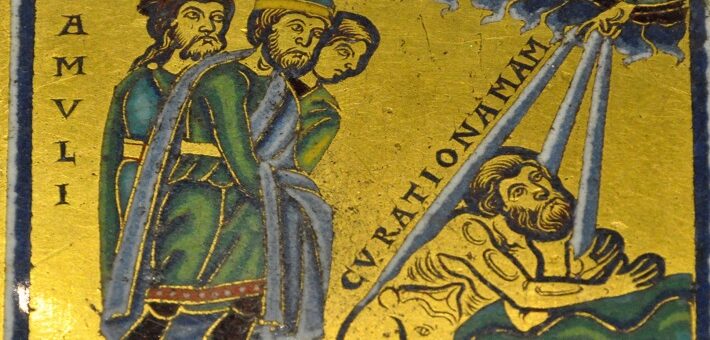Commentary on 2 Kings 5:1-15a
This week’s text has multiple possibilities for preaching, and each of them might be embedded within the larger theme of the reversal of expectations, especially as they intersect with the presence of power.
Is there a god or prophet in Israel?
Whether or not there is a prophet in Israel and the status of Elisha as the successor of Elijah has been fodder for thought and the impetus for the actions of people leading up to this point in the book of 2 Kings. In chapter two there was a declaration that the spirit of Elijah rested on Elisha, and it was followed by a test to ensure that Elijah had not simply been misplaced forcibly or mistakenly (2 Kings 2:15-17). In chapter 3 King Jehoshaphat of Judah inquires “Is there no prophet of the Lord here, through whom we may inquire of the Lord?” A servant of the king of Israel answers with “Elisha…” (2 Kings 3:11). A series of miracles and healings get us to this particular story. For instance, there is the miracle of the conception and birth of the Shunammite woman’s son, followed by his birth, sudden illness unto death, and resurrection. It could be read as being just as much about the woman’s persistent faith, as it is read as showing the capacity to which the word of the Lord is with the prophet. Verse 15 of 2 Kings 5 bookends this first half of the passage with an acknowledgement of God dwelling in Israel. God’s presence is made evident through the restoration of Naaman’s body, which results from his reluctant attentiveness to the direction of Elisha to wash in the Jordan seven times.
Multifaceted power
Power dynamics are present and internal to the story of the text, which the writer may have most wanted to underscore. This includes the existence and capabilities of the God of Israel and the prophet in contrast to the human markers of power. Human markers entail status, monarchy, and currency. The capacity of the God of Israel and prophet seem to make use of, move around, or in rejection of human signifiers of capability. We could move quickly to a discussion of this text at a macro level, in terms of the structure of power and the means of God versus the means of human means. However, such a move may miss the very bodily nature of the text. Displays of power at work are attached to bodies in this passage. They are present in the significant way people are named and unnamed, who knows the nature of the God of Israel and the prophet, and who takes and gives direction based on this knowing. Bodies, including their physical state, position, and movement carry forward the story. More importantly, both unnamed and named bodies push the tempo of the plot all the way to its very end, which then intonate an affirmation of both God’s word and presence.
Bodies in the text
Naaman is the “commander of the army of the king of Aram” (2 Kings 5:1). We are introduced quickly to Naaman suffering from leprosy, which seems to be in contrast to his authority and status as being one who is favored by the king and a great warrior. “The man though a mighty warrior, suffered from leprosy.” Leprosy is introduced as the interfering foil to his stature in society. He is one known for physical prowess as a warrior, possessing social capital with the king of Aram, and has been granted favor because his body is the one through which “the Lord had given victory to Aram.” And now, an illness has attacked his body.
A “young girl” is introduced as being taken from the land of Israel when the Arameans raided the land (2 Kings 5:2). The capturing and moving of this young girl first centers us as readers to the reality that Israel does not have the full measure of its monarchical power. The unnamed young girl forcibly dwells as a servant to the wife of Naaman. She is the one with knowledge of the prophet in Samaria who can cure Naaman. As a captured foreign servant, she makes a verbal emphatic declaration. First, that there is a prophet in Samaria; and second, that the prophet can cure Naaman.
The observant statement of the young girl places a cycle in motion. The wife of Naaman, also unnamed beyond her relationship to Naaman, carries the message to her husband. Quite possibly, the young girl has risked speaking to her mistress, “the wife,” with threat of dismissal; and “the wife” has risked carrying the message to Naaman and faces the threat of dismissal. The stakes continue as Naaman goes to the king of Aram carrying the message of the young girl held captive from the land of Israel. And then, the egos of the king of Aram and king of Israel contend when the king of Israel perceives the improbable request to cure Naaman as a provocation to a possible physical battle of bodies, yet again. While tearing his clothes in distress, he states: “Am I God, to give death or life, that this man sends words to me to cure a man of his leprosy?” Just look and see how he is trying to pick a quarrel with me.” However, Elisha sends word that this is an opportunity to reify that there is a prophet in Israel.
It cannot be lost that the word of the Lord and restoration presents in this narrative as something that is counter intuitive to a system founded in violence, war, plunder, forced submission, and the grand performance of bodies. At every turn the body least valued between two or three has an alternative approach or solution to the one expected. The young servant girl knows of a prophet who can heal; Elisha does not conjure the act of restoration in the provocative manner Naaman anticipates; and the servants of Naaman bring themselves face to face with Naaman to call the question “If the prophet had called you to do something difficult, would you have done it? How much more, when all he said to you was, ‘Wash, and be clean’?” Naaman’s physical submersion of his body into what he deems the deficient waters of the Jordan is what restores his flesh to that of a young boy. And as his physical body was restored and made clean he declares his revelation about the God of Israel, “Now I know there is no God in all the earth except in Israel” (2 Kings 5:15).
Considerations for preaching
The text is often examined and preached with attention to Naaman’s reluctance; the standoff between the king of Israel and the king of Aram; Naaman’s expectations of the wonders and signs of the miraculous; and the ultimate actions that led to the restoration of Naaman’s body. These are all valid starting places. And yet, changing our vantage point turns up the volume on the already existing implications of these starting places. In short, the in-breaking of options for restoration and the final affirmation of the God of Israel are pushed forward by the most vulnerable people in this story, be it vulnerable by captivity, gendered hierarchies, the imbalanced power of war, physical illness, or expectations of religious traditioning. We lose the complexity of the reversal of expectations and interruptions to displays of power if we dislodge the story from the people participating in its plot.
With a shift in vantage point, also comes a shift of responsibility and accountability to not only the bodies in the text, but most importantly, the bodies in our world today. If we recover the bodies of this text, we almost must recover its physical restoration. The words of the passage used to denote the miraculous hoped for and final fate of Naaman’s physically ill body vary from cure (2 Kings 5:3, 6, 11), restored (5:6, 10, 14), and to restored and clean (5:10, 13, 14). Whatever direction the preacher takes, there are harmful implications for people who live in our midst today when we synonymously collapsing cure, restoration, healing, and being “cleansed.” And these decisions are further complicated by leprosy being an illness (and others) that exists in both the biblical world and our world today. Our interpretive decisions always have pastoral dimensions, and our hope is to offer just care. The question for the preacher is “How do we hold the hope for the miraculous and healing in tension with the ableism and deadly assumptions that malign some bodies more than others?”
The aspect that seems most clear is the need for the preacher to make a particular decision about where they will enter the passage. And then, trace the implications of their final claim all the way out to how those claims intersect with the world today. This tracing includes being aware of the power dynamics at play in both the world of the text and our world. It also includes the cautions we need to consider when preaching texts that ultimately intersect with the lives and literal bodies of people today. Here is where the most vulnerable bodies of our world push us further along in the plot of identifying and naming the presence of God in our midst.
PRAYER OF THE DAY
Healing God, you healed your servant Naaman of his affliction when he came to you, through Elisha, for help. Heal our afflictions, and make us faithful servants. We pray these things in the name of Jesus Christ, our Savior and Lord. Amen.
HYMNS
For all the saints ELW 422, H82 287, UMH 711, NCH 299
I sing a song of the saints of God H82 293, UMH 712, NCH 295
Lift high the cross ELW 660
CHORAL
The souls of the righteous, T. Tertius Noble


November 4, 2018